
WEDNESDAY, SEPTEMBER 17, 2025


WEDNESDAY, SEPTEMBER 17, 2025
John Oliver
So, you want to be a Josephine County Commissioner? Congratulations, friend. You’ve chosen a path that, on paper, comes with responsibility, ethics, transparency, and a legal charter older than some of the neckties still hanging in the courthouse closet. But in practice, at least in our corner of Southern Oregon, the rulebook often looks less like Oregon Revised Statutes and more like a satirical Mad Libs scribbled at the back of a county fair beer tent.
According to state law, county commissioners are supposed to adopt ordinances that follow the law, hold open meetings that are truly open, manage budgets with citizen input, appoint people fairly to boards and committees, file ethics disclosures, avoid conflicts of interest, and generally keep their noses clean. Josephine County even has a home-rule charter—our own local constitution—that spells out commissioners’ duties, term lengths, and procedures. On
paper, it’s neat, tidy, and democratic.
But this isn’t Josephine County Commissioners for Saints. This is For Dummies. And the version of the manual that seems to have actually been written by our current board looks a lot different. In most counties, you campaign by talking to voters, laying out your vision, and promising to serve with integrity. In Josephine County, however, the “Dummies” edition starts with the Golden Rule: lie, deny, and deflect. If the truth gets in the way, push it aside like an inconvenient pothole on Foothill Boulevard. Our commissioners have practically trademarked the art of the non-answer. Ask about the budget shortfall and you’ll hear about a shadowy “threat” at a past meeting instead. Question the wisdom of a new appointment and expect to be told that transparency is overrated. In this county, elections aren’t won on ideas; they’re won on volume—and not budgetary volume, but the kind that echoes off courthouse walls when a commissioner
scolds a constituent.
The law is crystal clear that meetings must be open to the public, announced ahead of time, and recorded in minutes. Citizens are supposed to have a say. That’s why Oregon’s Public Meetings Law exists. But the “Dummies” edition reads differently. Public comment is limited to three minutes and often met with eye rolls. Passionate speakers are shushed. “Executive session” becomes a magician’s smoke bomb, used whenever things get sticky. Transparency is met with sighs and vague explanations about security that sound like they came from a bad spy novel. The result is meetings that feel less like open forums and more like parent-teacher conferences where the parents are grounded for asking too many questions.
By law, the county budget must be crafted with input from a citizen budget committee. Hearings
• see BECOME, page 7

By John Oliver
The legal proceedings surrounding the assassination of conservative activist and media figure Charlie Kirk have entered a decisive new phase, as prosecutors in Utah formally filed charges against the suspect, Tyler Robinson, and announced their intent to pursue the death penalty. The announcement marks one of the most consequential cases in recent state history, both for the severity of the charges and the intense national attention surrounding the incident.
Robinson, 22, was arrested following the fatal shooting of Kirk on September 10 during a public appearance at Utah Valley University in Orem. The attack occurred in front of a large audience, shocking attendees and sparking an immediate response from law enforcement. Investigators allege that Robinson fired a single round that struck Kirk in the neck, causing fatal injuries despite attempts by medical personnel to save his life. The incident set off chaos within the venue, with students and guests scrambling for safety as authorities secured the scene.
In the days that followed, police and federal agents launched an intensive investigation into Robinson’s actions, background, and potential motives. Prosecutors have now confirmed that Robinson faces multiple charges, including aggravated murder, a capital offense in Utah. The decision to pursue the death penalty underscores the seriousness with which officials
are approaching the case, signaling their belief that the nature of the crime warrants the maximum punishment available under state law.
The decision has reverberated beyond Utah, drawing commentary from political leaders, legal scholars, and activists across the country. While capital punishment remains legal in Utah, it is rarely sought, and even more rarely imposed. The case is likely to reignite national debates over the death penalty, free expression, and the vulnerability of public figures in an era of heightened political division.
Charlie Kirk, who was 31 years old, had built a prominent career as a conservative commentator, activist, and speaker. As founder of Turning Point USA, he was known for engaging with young audiences on college campuses across the nation, often sparking strong reactions from both supporters and opponents. His death has left a void within conservative circles, while also drawing condolences from across the political spectrum as public figures acknowledged the tragedy of the loss.
Robinson’s initial court appearances have already drawn significant public attention, with packed courtrooms and large gatherings of both supporters and critics outside the courthouse. Security has been heightened at each proceeding, reflecting concerns about the charged atmosphere surrounding the case. Prosecutors have made clear that they intend to pursue a
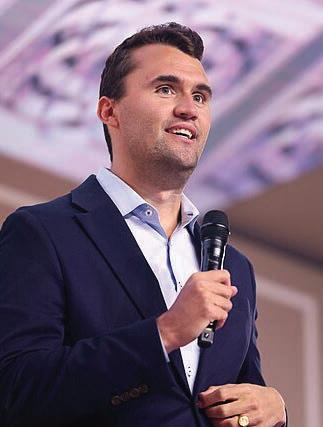
swift trial, but defense attorneys are expected to mount a vigorous case challenging both the charges and the pursuit of capital punishment.
Legal experts note that death penalty cases are inherently complex, often taking years to move through the courts due to mandatory appeals and heightened scrutiny. If Robinson is convicted, the sentencing phase will be a focal point for arguments about justice, proportionality, and the broader implications of the punishment. For now, he remains in custody without bail, awaiting further hearings as the case advances.
The assassination of a nationally recognized commentator during a live event has
amplified concerns about security at public gatherings, particularly on university campuses. Administrators at Utah Valley University have already begun reviewing security protocols, and other institutions are likely to follow suit as organizers consider how to protect high-profile speakers without undermining the accessibility of public discourse.
As Utah prepares for what is certain to be one of the state’s most closely watched trials, the broader national conversation continues. For supporters of Kirk, the pursuit of the death penalty represents a measure of justice for an act they view as an attack not only on an individual but on the principles of open debate. For critics of capital punishment, it raises fundamental questions about whether the state should respond to violence with the ultimate penalty.
What remains clear is that this case will shape legal and political discussions well beyond the courtroom, placing Utah at the center of a national dialogue about crime, punishment, and the responsibilities of a society confronting the consequences of political violence.

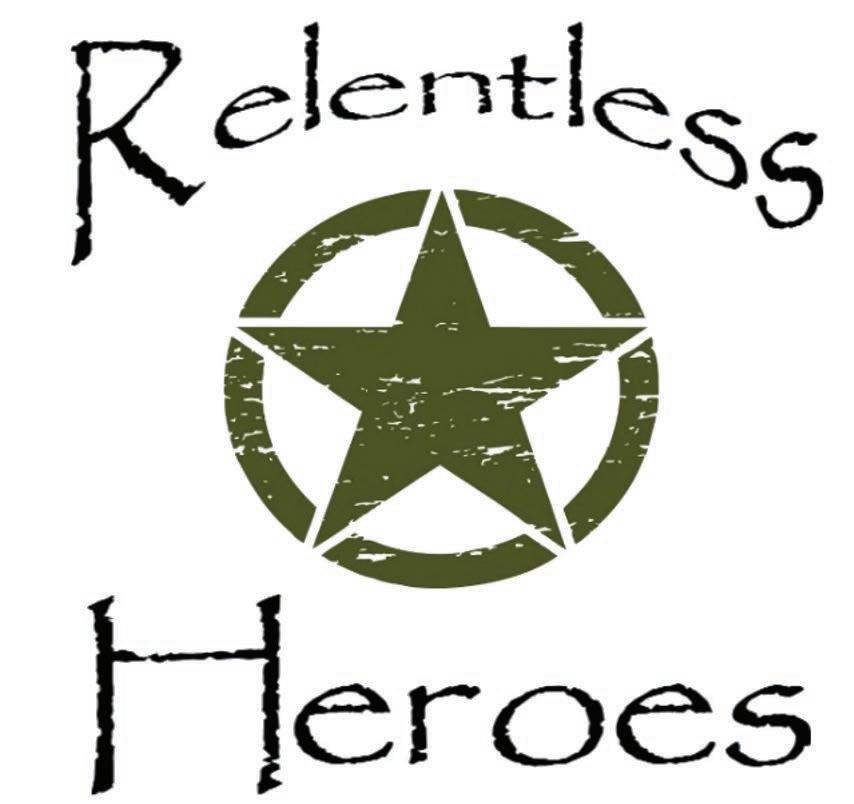
PRESENTS ITS 12TH ANNUAL RELENTLESS DEVASTATIONAL GOLF TOURNAMENT @ Grants Pass Golf Club September 20th | Tee Time @ 9:00 AM
2-man scramble
18 holes with cart
$250 per Team Lunch, Driving Range, & Contest Entries Included
For early registration or Sponsorship Information contact Eric Hennings 541-659-6136 Or Chris Hennings 541-601-0750 www.relentlessheroes.org
Raffle, Silent Auction, Prizes & Games ALL PROCEEDS GO TO LOCAL VETS


By Ellen Ward
The criminal case against Luigi Mangione, the man accused of fatally shooting UnitedHealthcare Chief Executive Officer Brian Thompson, took a significant turn on Tuesday when state terrorism charges were dismissed during a pre-trial hearing in Manhattan. Mangione, who has remained in custody since his arrest earlier this year, continues to face murder and related counts in connection with Thompson’s death, but prosecutors confirmed that the terrorism enhancements would no longer proceed.
The courtroom at Manhattan Criminal Court was filled well before the hearing began. Members of the press, along with a large contingent of the public, packed the benches to witness the proceedings. Mangione, dressed in tan prison attire and shackled at the wrists and ankles, entered the room shortly before 9:30 a.m. His appearance marked the latest step in a case that has drawn widespread attention not only for the high-profile status of the victim, but also for the legal and political debates it has triggered.

Outside the courthouse, a crowd of Mangione’s supporters gathered on the steps and sidewalks, carrying hand-made signs and chanting slogans in his favor. The demonstration, which was closely monitored by police, underscored how the case has evolved into a public spectacle beyond the legal questions at stake. For prosecutors, the dismissal of terrorism-related counts was a tactical decision, though officials declined to elaborate on their reasoning in court. Legal analysts noted

that proving terrorism charges often requires a high threshold of evidence to show political or ideological motivation, beyond the act of violence itself.
The hearing centered on several pre-trial motions, including procedural disputes over evidence and witness testimony. Attorneys for both sides spent much of the morning navigating these issues, while the judge emphasized the importance of keeping the case on schedule as it moves toward trial. No new trial date was set, but the court indicated that proceedings are expected to continue later this fall.
The killing of Thompson, who led one of the largest health insurance companies in the nation, sent shockwaves through the corporate and financial sectors earlier this year. His death prompted an outpouring of tributes from colleagues, as well as concern over potential security risks facing executives of major corporations. Mangione’s arrest shortly afterward led prosecutors to initially frame the case as both a criminal act and a potential
act of terrorism, though that approach has now been scaled back.
With terrorism charges off the table, the case is expected to focus squarely on the murder allegations and the evidence surrounding Thompson’s death. Legal observers say this shift could streamline the trial, though it may also alter public perception of the case. While prosecutors will continue to argue that Mangione deliberately targeted Thompson, the defense is expected to challenge the circumstances of the arrest and the interpretation of key evidence.
For now, Mangione remains in custody awaiting further hearings. The dismissal of terrorism charges represents a narrowing of the state’s approach, but the most serious accusations remain unresolved. As the courtroom proceedings continue, both the public and the business community are watching closely, knowing that the eventual verdict will carry implications not just for Mangione, but for the broader discussion about safety, accountability, and the law in high-profile cases.
















Advertise with The Grants Pass Tribune!
Stand with us in defending freedom of the press and the 1st Amendment! The Grants Pass Tribune is facing political persecution, with lawsuits aimed at silencing our bold investigative journalism. We remain committed to uncovering the truth and keeping our community informed like never before.
Show
By John Oliver
Israel launched a large-scale offensive in Gaza City on Tuesday, escalating a campaign that has already left much of the enclave in ruins after nearly two years of air raids, shelling, and ground operations. The renewed assault has sparked another mass displacement of civilians, further straining a population that has endured repeated waves of violence and destruction.
The offensive began in the early hours of the morning and by mid-day, reports from the area described heavy bombardment across northern neighborhoods and intensified ground maneuvers on the city’s edges. Military vehicles and personnel were seen moving toward the center of Gaza City, while airstrikes rattled an already devastated urban landscape. Entire districts that had previously been reduced to rubble faced fresh waves of firepower, leaving residents with little certainty about where to turn for safety.
The attack triggered a new surge of displacement as families scrambled to leave the city. A coastal road leading south quickly filled with vehicles stacked high with mattresses, furniture, and household

belongings, bearing witness to the hurried exodus. Humanitarian observers reported thousands of cars, trucks, and carts packed with families attempting to flee the violence. Yet despite the visible rush to escape, relief groups estimate that hundreds of thousands remain trapped inside Gaza City, unable to leave due to lack of transport, financial resources, or safe passage. The offensive marks one of the most significant escalations in recent months. For residents, it is another devastating chapter in a conflict that has steadily erod-
ed basic living conditions. Infrastructure is severely damaged, electricity remains intermittent at best, and medical facilities are struggling to function under constant strain. Humanitarian agencies have repeatedly warned that the city is at risk of total collapse if the fighting continues without pause.
International reactions were swift, with neighboring states and aid organizations expressing concern over the humanitarian impact. Calls for restraint and protection of civilians grew louder as reports of new ca-
sualties emerged. Diplomats warned that the operation could destabilize the broader region, complicating ongoing mediation efforts aimed at reducing hostilities. Despite these appeals, Israel has signaled that its campaign will continue until it achieves what officials describe as the neutralization of militant infrastructure embedded within Gaza City.
For Palestinians, however, the immediate reality is defined less by political declarations and more by the daily struggle to survive. Families continue to make impossible choices—whether to stay in homes that may soon be struck or to risk perilous journeys southward in search of shelter. Aid convoys have struggled to reach those in need, and resources remain scarce. Food, clean water, and medical supplies are all in critically short supply.
As the fighting presses on, Gaza City faces the prospect of being overwhelmed not only by military force but by the cascading consequences of prolonged destruction. Entire communities that once thrived along the Mediterranean coast now teeter between displacement and despair, with no clear end in sight.
By John Oliver
Robert
Redford,
one of the great luminaries of American cinema, died today at his home in Sundance, Utah, at the age of 89. Born Charles Robert Redford Jr. on August 18, 1936, in Santa Monica, California, his life eventually became larger than any screenplay, woven from artistry, activism, warmth, and a restless integrity that refused to settle for the safe or obvious. He leaves behind more than a body of work; he leaves a legacy of possibility, of daring, of art in service of truth, beauty, and hope.
From modest beginnings, Redford first showed an early interest in art and storytelling. His family moved when he was young; he studied painting at the Pratt Institute and later acting at the American Academy of Dramatic Arts. Before long, he turned toward the stage and then the screen, making television appearances in a wide array of roles. He had a natural presence, an almost luminous quality of charisma, but he was never content just to resemble a Hollywood leading man. He worked to expand his range, to dig into roles that tested him, sometimes even rejecting parts when they didn’t feel genuine.
His breakthrough came in the 1960s and early 1970s, in films that have since become permanent in the national imagination: Barefoot in the Park, Butch Cassidy and the Sundance Kid, The Sting, All the President’s Men, The Way We Were. Over decades he showed a rare versatility: romantic, rebellious, haunted by moral complexity. Eventually he shifted into directing as well, winning the Academy Award for Best Di-
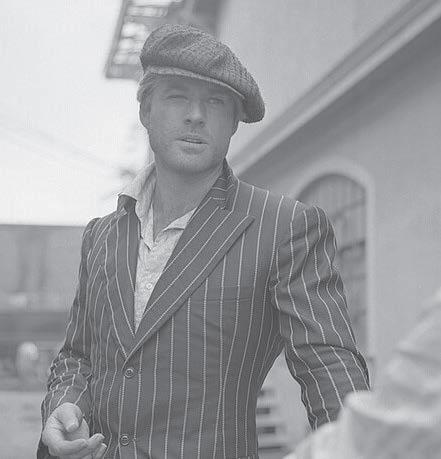
rector in 1980 for Ordinary People, a film that looked—without flinching—at grief, loss, family dynamics. Other directorial efforts—A River Runs Through It, Quiz Show, The Horse Whisperer among them—combine visual richness, human fragility, ethical questioning. He seemed always drawn not only to what people show to the world, but to what lies deeper: regret, longing, the pull between idealism and compromise. But what perhaps distinguishes Redford most among his peers is his deep commitment to creating space, literally and metaphorically, for voices outside the center of the Hollywood machine. He co-founded the Sundance Institute and the Sundance Film Festival, through which countless filmmakers have found an audience, an opportunity, a foothold. He believed that independent film could do something that big stu-
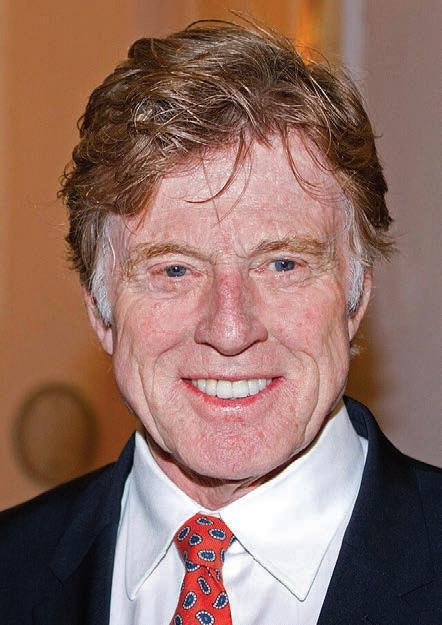
dios sometimes cannot: tell stories that matter, stories that are harder, quieter, riskier, stories that interrogate rather than merely entertain. His work in environmentalism, in supporting Native American rights, in advocating for art and artists, shows someone who saw his own celebrity not as an end but as a tool, as a platform. In his personal life, Redford bore his share of loss and contradiction. He married twice. His first marriage was to Lola Van Wagenen in 1958, with whom he had four children: Scott, who died in infancy; Shauna; James, who died in 2020; and Amy. In 2009 he married the artist Sibylle Szaggars, after a long partnership. Those who knew him speak of a generous presence, someone who could light up a room but also withdraw when needed, someone tied to the land—the mountains of Utah, the West in general, big sky,
wide spaces—that inspired many of his films. Redford had quirks and contradictions. His beauty and leading-man magnetism were always part of his image, but he chafed at being typecast for looks alone. He rejected roles, held off on some opportunities, all so he could preserve integrity in his choices. In later years his voice grew softer, his gaze deeper, and he seemed less willing to play the rules other people had set. He loved nature not just as backdrop, but as something worth protecting. He invested in small-scale film, in nurturing young talent, in building institutions that outlast any single performance.
His death marks the end of an era, and yet what Redford created will continue. Every festival that screens a first film, every independent filmmaker who gets a chance because Sundance said yes, every viewer who finds solace or challenge in a film that asks questions—that is part of what he built. He will be remembered not merely for his handsome face or iconic roles, but for someone who carried on a belief in what cinema can be: beautiful, moral, open to surprise, and above all, human.
When people look back, they will see Robert Redford as a man who combined star power with humility, talent with conscience, fame with kindness. He leaves behind a world richer for his stories, his stewardship, his dream that film could shine light into dark places, could bind us together even when we disagree. He will be sorely missed, but his voice lives on—in every new filmmaker, in every screen that dares to imagine more than what is easy.





Tired of doing everything "right" and still feeling exhausted, bloated, and stuck?
At Elysian Women's Wellness, we specialize in helping women 35–55 balance their hormones, heal their metabolism, and lose stubborn weight without crash diets or two-hour workouts.
We use our Metabolic Optimization Method to help you feel like you again.
• Functional & traditional lab work
• Sustainable weight loss
• Hormone-friendly exercise & nutrition
• Expert support & accountability
From page 1
are required. Numbers must be posted. Sunshine is expected. But in the Dummy version, the budget is treated like a mystery novel. Facts are redacted, citizen input brushed aside, and appropriations passed faster than you can say “supplemental budget transfer.” Anyone trying to follow the dollars might as well be reading hieroglyphics. Instead of prioritizing services like roads, law enforcement, or libraries, the commissioners tend to prioritize self-preservation. Budgets become political shields rather than planning tools.
Oregon’s ethics laws are equally clear. Don’t use your office for personal gain. Don’t accept gifts beyond limits. Disclose your financial ties. Avoid bullying the public. Yet in Josephine County, the Dummy handbook recommends the opposite. Conflict of interest? Pretend it doesn’t exist. Gift limits? Redefine “gift” until it means free donuts in the break room. Statements of Economic Interest? File them as casually as you’d sign for a UPS package, if at all. And when criticism arrives, don’t respect it—attack it. Citizens are dismissed as hecklers, journalists are painted as troublemakers, and transparency advocates are branded as threats. Ethics are treated not as guardrails but as obstacles.
When it comes to land use and appointments, commissioners are supposed to follow zoning laws and state planning rules while appointing volunteers to boards based on merit. In practice, the Dummy approach is to spin the wheel. Appointments go not to the qualified but to the loyal. Land-use decisions feel like backroom favors. If you’re friendly to the board, you get a seat. If you’re critical, you get silence.
Oregon law guarantees public access to records, but here again the Dummy version turns it into a game of hide and seek. Requests are delayed, deflected, or buried under jargon until the requester finally gives up. Transparency is treated like sunlight in a vampire novel—something to be avoided at all costs.
And yet, beneath the satire lies a truth that isn’t funny at all. The role of a county commissioner is one of the most important elected offices in Josephine County. Commissioners shape land use, oversee millions in tax dollars, and represent us on regional and state boards. Their decisions affect everything from public health to public safety. The system is designed for accountability, transparency, and ethics. But when commissioners ignore the charter, shrug off state law, and mock the very citizens they serve, the damage is real. Trust erodes. Engagement declines. And democracy, already fragile, starts to crack. If Josephine County is stuck with commissioners reading from the “For Dummies” edition, then the joke is on us. But the punchline doesn’t have to be permanent. Voters, citizens, and community advocates still have the power to rewrite the script. The original rulebook—the charter, the statutes, the ethics code—isn’t broken. It’s just being ignored. What’s broken is the culture of entitlement and disdain coming from the courthouse dais. The real “For Dummies” lesson is simple: don’t let the dummies keep the pen. Take it back. Demand transparency. Expect ethics. Elect leaders who respect the people they serve. Because Josephine County deserves more than a parody. It deserves commissioners who can read the real manual, not just the joke version.







By John Oliver
Josephine County residents concerned about animal neglect, abuse, or nuisance issues are now being directed to a newly updated complaint link maintained by the Sheriff’s Office. The change comes as ongoing debates persist over how local authorities investigate and prosecute cases involving animal welfare.
Animal Control and Regulation operates under the authority of the Sheriff, while the county’s Animal Shelter is overseen by the Health Department. The separation of responsibilities has caused some confusion among residents who are uncertain where to report problems or how their complaints are handled once submitted. To streamline the process, the Sheriff’s Office has centralized reports through an online form, encouraging the public to document potential violations ranging from hoarding to neglect.
Despite the updated complaint process, community members remain skeptical about whether investigations will result in meaningful enforcement. Residents point to past cases where Animal Control officers investigated allegations, gathered evidence, and submitted findings, only for the District Attorney’s office to decline to pursue charges. Advocates argue that even when strong cases are built, the likelihood of prosecution is low. They believe that this lack of follow-through undermines confidence in the system and leaves vulnerable animals without proper protection.
One of the more widely discussed examples involves a local breeder case that became the subject of extended le-

gal proceedings. Community members claim that despite raids and the seizure of animals, charges were ultimately reduced or resolved through plea agreements. That outcome, they say, reflects a broader pattern where complex animal welfare cases drag on for years with little accountability. In this case, more than three years have passed since authorities raided two facilities, yet many residents feel justice has not been served.
The frustration stems from the slow pace of investigations, limited prosecutorial action, and the perception that the legal process does not prioritize animal welfare. Advocates describe a cycle in which complaints are filed, officers conduct their work, and cases are built, but the final step of legal enforcement rarely arrives. Some also point to the challenges faced by prosecutors, who may weigh limited resources, competing priorities, and the difficulty of proving intent in neglect or abuse cases when deciding whether to proceed.
Local officials emphasize that the
complaint form remains an essential tool for residents who witness or suspect mistreatment. Filing reports ensures that concerns are documented, investigated, and monitored. The Sheriff’s Office has stated that Animal Control continues to take complaints seriously and respond accordingly. Still, for many in the community, the ultimate concern is not whether investigations happen, but whether they lead to lasting outcomes that protect animals and hold violators accountable.
The issue has become a focal point for animal advocates who want greater transparency in the handling of cases and stronger collaboration between county departments and the District Attorney’s office. They argue that without visible consequences for violators, the cycle of abuse and neglect will continue unchecked. As Josephine County updates its complaint system, the community continues to watch closely, hoping that the shift will lead to improved oversight and meaningful results.
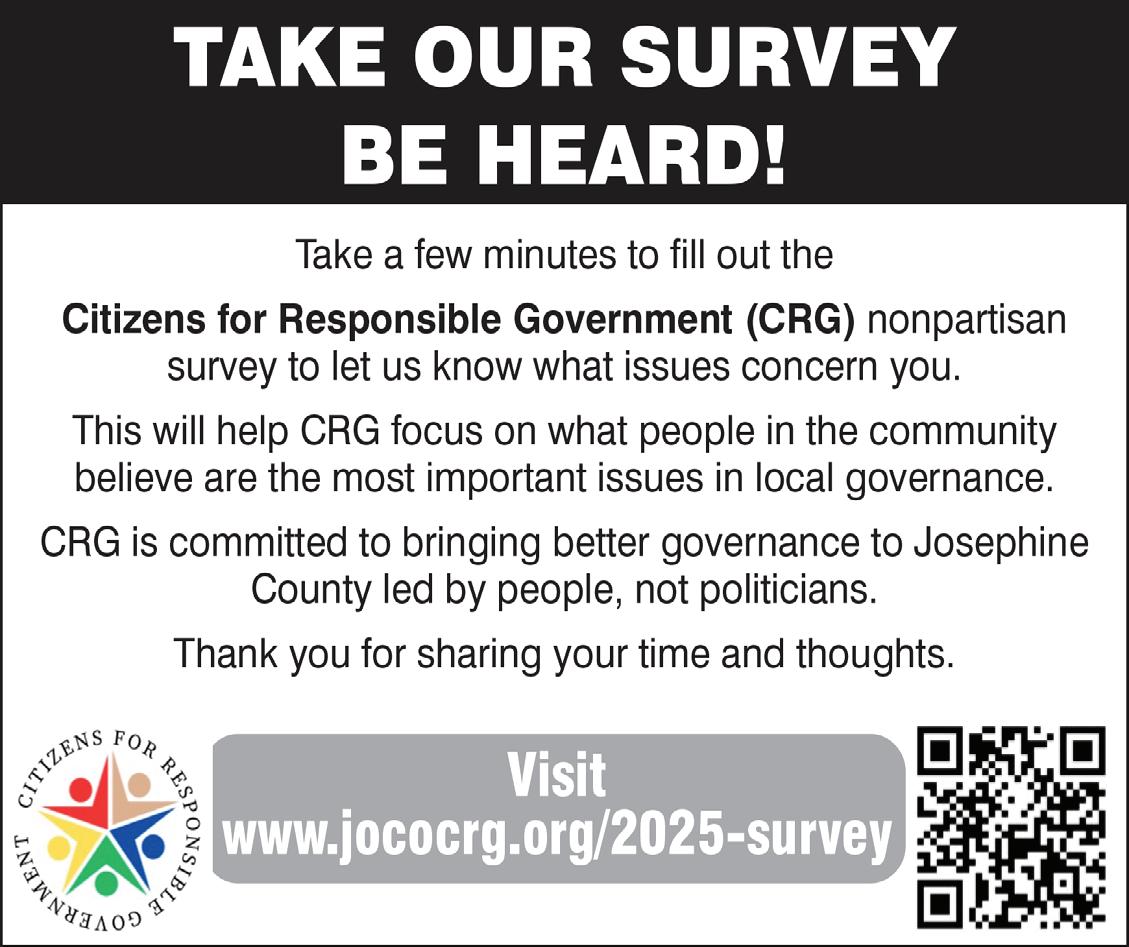
5 DAY OUTLOOK SOURCE: WEATHER.COM

















Posting Date September 15, 2025
Posting September 15, 2025